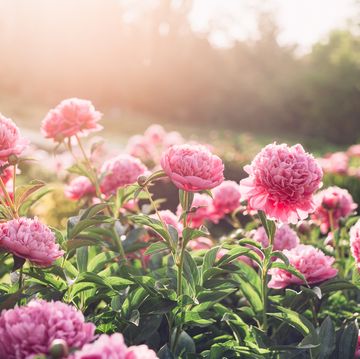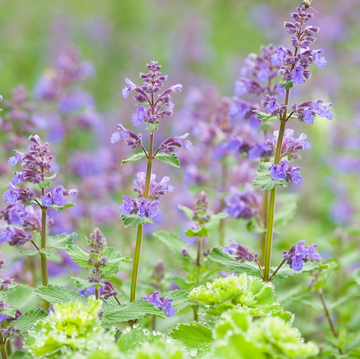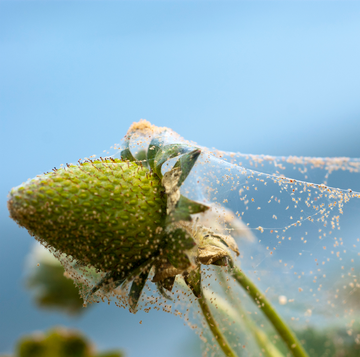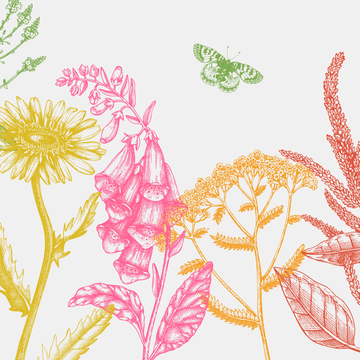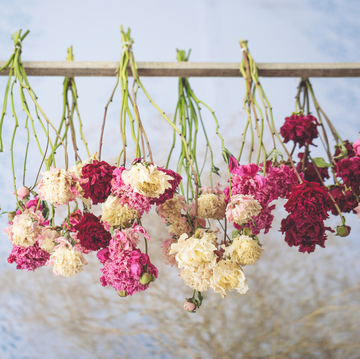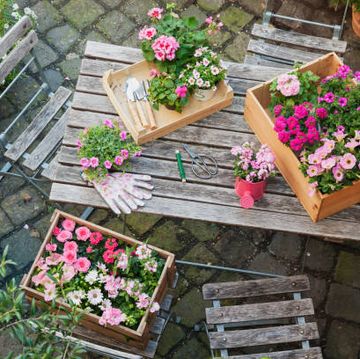1Camellias
 Jacky Parker Photography//Getty Images
Jacky Parker Photography//Getty ImagesClayton says that these beauties are great for winter color. “They prefer milder winters, so they’re perfect for the Southeastern US,” he explains, adding that they love the humidity the south is known for, even in winter. “Plant them in partial shade and well-drained soil.” Best of all, you’ll get plenty of mileage out of these plants since they begin blooming in late fall and can continue to do so into early spring.
SHOP CAMELLIAS
Advertisement - Continue Reading Below
2Cyclamen
 Melissa Matheson / 500px//Getty Images
Melissa Matheson / 500px//Getty ImagesIf you live somewhere that has mild winters, you may be able to bring the beauty of this houseplant into your yard where both you and the wildlife can enjoy its splendor. Grown in USDA Hardiness Zones six to eight, these plants like partial shade and will go dormant during the warmer summer months.
SHOP CYCLAMEN
Advertisement - Continue Reading Below
3Winterberry
 Johnathan A. Esper, Wildernesscapes Photography//Getty Images
Johnathan A. Esper, Wildernesscapes Photography//Getty ImagesThe berries that are produced by this shrub are a key food source for birds late in the season, according to Sara Abbass, owner of Sara Mairead Landscape Design, co-founder and executive board member, Northport Native Garden Initiative.
“You’ll want to plant this in the spring or fall and expect it to take one to three years to establish before steady berry production,” she explains, noting that this plant will need both a male and female to produce berries, so you’ll want to plant them in pairs.
SHOP WINTERBERRY
Advertisement - Continue Reading Below
4Pieris
 magicflute002//Getty Images
magicflute002//Getty ImagesThis beautiful plant comes with dainty, bell-like flowers that can be grown in a variety of different colors, including shades of white, pink, and red. Plant your seeds in a well-draining area that gets full sunlight in colder climates and partial shade in warmer areas after the danger of the last frost has passed in the spring.
This evergreen will remain visually appealing during the summer months thanks to its vibrant green foliage, switching over to floral production in the late winter.
SHOP PIERIS
Advertisement - Continue Reading Below
5Red Twig Dogwood
 Bogdan Kurylo//Getty Images
Bogdan Kurylo//Getty ImagesWhile there are no winter flowers on the Red Twig Dogwood, Abbass says it’s a must for our list due to the stunning color it adds to the garden. “Once the Red Twig Dogwood sheds her leaves, you’ll find that the stems are a vibrant red,” she explains. “These are great to plant in the spring, to be able to enjoy their blooms all the way into the winter months when the stems shine in the garden.”
If you don’t have a ton of space in your yard to add a tree, Abbass says you can opt for a more petite pick. “A dwarf variety, ‘Arctic Fire’ grows smaller than the straight species and can be better suited for a residential landscape.” Planting a small mass provides an intense pop of color, especially against a fresh snowfall, according to Abbass, which makes this a great pick for those who miss the bright hues of spring and summer.
SHOP RED TWIG DOGWOOD
Advertisement - Continue Reading Below
6Leatherleaf Mahonia
 Photos from Japan, Asia and othe of the world//Getty Images
Photos from Japan, Asia and othe of the world//Getty ImagesLooking for some deep purples and blues this winter? Checkout this Oregon Grape plant. This shrub can grow up to six feet tall and it produces ornamental berries that will bring all the critters to your yard. Plant in full sun and give this shrub plenty to drink and you’ll get to watch it thrive all winter long.
SHOP LEATHERLEAF MAHONIA
Advertisement - Continue Reading Below
7Winter Jasmine
 Catherine McQueen//Getty Images
Catherine McQueen//Getty ImagesIf you live in USDA Hardiness Zones six to 10, you’ll be able to enjoy a bit of added winter interest in your garden by way of this Chinese native. “Plant it in well-drained soil with some sun, and it’ll give you bright yellow flowers even in the dead of winter,” Clayton says.
Just note, despite its name, Winter Jasmine doesn’t have the same sweet floral smell as other varieties, so these blooms won’t be accompanied by the telltale fragrance other Jasmines are known for. That being said if you live in the plant’s “sweet spot”—something Clayton says can be found in the cool, moist climate of the Northwest—you’ll still get to enjoy all the visual beauty this plant has to offer.
SHOP WINTER JASMINE
Advertisement - Continue Reading Below
8Primrose
 LeliaSpb//Getty Images
LeliaSpb//Getty ImagesThese delightful and cold hardy flowers come in a variety of colors, which makes them perfect for adding those much-needed pops of color to your winter landscape. Simply plant your seeds in the fall, adding them somewhere that will have light shade during the growing season, so that you can enjoy them when everything else is bleak and gray.
SHOP PRIMROSE
Advertisement - Continue Reading Below
9Wintergreen
 Oleg Charykov//Getty Images
Oleg Charykov//Getty ImagesAnother berry producer, Abbass says this broadleaf evergreen groundcover is ideal for planting in those part shade areas that you want to fill in over time. “You can expect white, bell-shaped blooms in the summer that eventually produce the berries you see beginning in the fall and persisting through the winter months,” she says, adding that you can plant these anytime from spring through the fall. “An attractive plant, the berries are also an important wildlife food source ranging from birds to small animals.”
SHOP WINTERGREEN
Advertisement - Continue Reading Below
10Snowdrops
 rolfo//Getty Images
rolfo//Getty ImagesSnowdrops are one of the first signs of spring, even if they do start to pop up before the weather starts to warm. “These are tough little flowers that can push through snow to bloom,” Clayton says of the Northeastern favorites. “Plant them in the fall in well-drained soil and partial shade, and you’ll see them pop up late winter.”
SHOP SNOWDROPS
Advertisement - Continue Reading Below
11Crocus
 Photos by R A Kearton//Getty Images
Photos by R A Kearton//Getty ImagesSimilar to snowdrops, the crocus is one of those winter beauties that can start coming up when the weather outside is still frightful. “Seemingly able to bloom just about anywhere, you will find Crocus in full-part sun in late winter through early spring months,” Abbass says. “An early bulb, plant these in the fall usually well before the threat of a hard frost.” Because these are perennials, you can expect these blooms to continue to bring you a winter delight year after year!
SHOP CROCUS
Advertisement - Continue Reading Below
12Pansies
 YuriF//Getty Images
YuriF//Getty ImagesClayton jokes that he’s planted more of these flowers than he cares to admit during his tenure as a landscape professional. And there’s a good reason why these “tough little guys” are such garden mainstays, and it has to do with their ability to survive a cold winter. “They need well-drained soil and a bit of sun but can handle the cold like champs,” Clayton continues. “Plant them in the fall, and they’ll bloom through winter into spring.”
SHOP PANSIES
Advertisement - Continue Reading Below
13Hellebores
 Alphotographic//Getty Images
Alphotographic//Getty ImagesAlso known as Christmas Roses, Hellebores are known to bloom in late winter or early spring. “Plant them in partial shade, and they’ll do fine with minimal care,” says Clayton of these low maintenance florals. “Plus, they’re perennials, so they’ll come back year after year.”
SHOP HELLEBORES
Advertisement - Continue Reading Below
14Daffodils
 Rosemary Calvert//Getty Images
Rosemary Calvert//Getty ImagesAnother late winter bloomer, Abbass says you’ll want to plant these bulbs in the early fall months of September and October before the threat of a hard frost. She says this will give the bulbs enough time to establish and develop roots before they go dormant for the winter. Available in various shades of yellow, these familiar spring flowers have been a popular choice for decades.
SHOP DAFFODILS
Advertisement - Continue Reading Below
15Winter Aconite
 Oksana_Schmidt//Getty Images
Oksana_Schmidt//Getty ImagesThis plant will add a bit of cheery yellow to your landscape, even when the rest of the colors of the season are still asleep. These low-growing plants appear before even the first Snowdrops start popping up, and you’ll get your first glimpses of them in the sunnier spots in your yard, so make sure you’re adding yours somewhere they’ll see lots of sun during the winter.
Just remember that these can be toxic to kids and pets if the tubers are consumed, so make sure you’re not planting them where the ground will be disturbed.
SHOP WINTER ACONITE
Advertisement - Continue Reading Below
16Witch Hazel
 Iva Vagnerova//Getty Images
Iva Vagnerova//Getty ImagesIf you’re looking for a flower that really likes to show off, Clayton says you’ll love Witch Hazel with its bright, fragrant flowers in the dead of winter. “Plant it in well-drained soil with full sun to partial shade,” he says, adding that while it’s a bit of a slow grower, it’s definitely worth the wait.
SHOP WITCH HAZEL
Advertisement - Continue Reading Below
17Pussy Willow
 Christine Rose Photography//Getty Images
Christine Rose Photography//Getty ImagesCatkins (the flowering spike of the willow) begin to appear in late winter and carry into early spring, according to Abbass, who says this creates “quite the show” for the shrub. “An important keystone plant for many species of bees and butterflies, this shrub will also attract migratory birds looking for hefty food sources,” she explains. “When the catkins open in early spring, these become one of the first blooms for overwintering pollinators such as mason bees.”
If you want to add this point of winter interest to your garden, you’ll want to ensure you’re giving it plenty of room to stretch its legs. “A great addition that needs plenty of space to grow and not too close to a structure, their root systems tend to explore into areas not wanted if near a foundation!” Plant them in wet soil with full to partial shade and watch them explode with life at the end of the season.
SHOP PUSSY WILLOW
Advertisement - Continue Reading Below
18Trumpet Honeysuckle
 DebraCarrPhotography//Getty Images
DebraCarrPhotography//Getty ImagesBlooming well into the winter in mild climates, Abbass says this hardy vine has been seen with blooms well into February. This is good for gardeners whose thumbs may skew more black than green, because Abbass says they’re fairly indestructible and can be planted year-round, which means you don’t need to do a whole lot of planning ahead of time. “Depending on your space, one plant would suffice and can be trimmed any time,” she says. “If you plant one of these vines, not only will the blooms delight in the winter, but you’ll most likely seem some hummingbird activity in the summer.”
Give it some light shade and medium moisture and your honeysuckle will thank you by blooming for months at a time.
SHOP TRUMPET HONEYSUCKLE
Advertisement - Continue Reading Below
19Virgin’s Bower
 Iuliia Petrovskaia//Getty Images
Iuliia Petrovskaia//Getty ImagesAnother vining favorite of Abbass’, this plant produces stunning flowers in the fall before transforming into something else entirely once winter comes to stay. “A unique transition from bloom to a feathery seedhead in late fall, persisting through the winter months,” she says. “An important plant for pollinators, this vine is utilized late into the winter for nest building by birds.”
Give it a home in some moist soil with partial sun.
SHOP VIRGIN’S BOWER
Advertisement - Continue Reading Below
20Winter Heath, Erica Carnea
 Carolyn Ann Ryan//Getty Images
Carolyn Ann Ryan//Getty ImagesA low-growing ground cover, Abbass says that this beautiful bloom will persist from winter into spring. “A showy bell-shaped bloom, this plant can tolerate part shade-full sun,” she continues. It sounds like Winter Heath can be planted just about anywhere in the yard, so you’ll want to ensure you’re putting it somewhere you’ll be able to enjoy, even if you can only look at it through the window while you stay bundled up inside.
SHOP WINTER HEATH

Lauren Wellbank is a freelance writer based in the Lehigh Valley region of Pennsylvania. Her work has appeared in The Washington Post, Huffington Post, Martha Stewart Living, and more. She has three small children, a husband, and an over eager dog at home. When she's not writing she likes to work in her garden with her family.
Advertisement - Continue Reading Below
Advertisement - Continue Reading Below
Advertisement - Continue Reading Below

